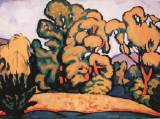

At the turn of the century, artists of the young generation at the Nagybánya school were no longer satisfied with plein-air naturalism which they had learnt from their masters, e.g. István Réti, Károly Ferenczy and János Thorma. Their attention was attracted to the art of Henri Matisse, a French artist, one of the most significant of his time. Of the founders, it was the style of Béla Iványi Grünwald which best reflected the influence of new trends in art (Nagybánya Landscape with Gutin, 1906).
Obviously, it was a must for everyone around 1905 and 1906 to visit Paris. On returning to Hungary, works showed that artists had become more aware of how important composition was, and daring colours were chosen deliberately. Harmony was no longer searched for: compositions were based on contrasting colours. They observed nature in a different way: in addition to portraying nature, towns appeared in pictures, too. It was, however, Béla Czóbel who went furthest. He took his pictures, shocking and harsh in colours to Nagybánya in 1906 (Painters Outdoors, 1906).
Artists who joined the trend referred to as neo-impressionism by their contemporaries, abbreviated as neos, included Tibor Boromisza, Dezső Czigány, Valéria Dénes, Sándor Galimberti, Vilmos Perlrott-Csaba, Lajos Tihanyi and Sándor Ziffer. Most of them stayed in Nagybánya for a few years only, but Vilmos Perlrott-Csaba used to visit the art school until the 30s (View of a Village). In his art, he managed to unite forms of cubism with colours of expressionism (Boys Bathing, around 1910). Sándor Ziffer, one of Simon Hollósy's ex-pupils, was even more consequent: following the advice of Béla Czóbel, a friend of his, he went to Paris, then to Nagybánya where he worked the rest of his life. Thus, Ziffer, first influenced by French art, then by German, remained a source of inspiration for artists in Nagybánya for several decades to come (Red Doorway, 1908, The Valley of Morgó, 1923).
The best-known representatives of Hungarian cubism included János Kmetty (Trees, around 1911), Imre Szobotka (Man Smoking Pipe, around 1911) and the couple of Valéria Dénes and Sándor Galimberti.
Artists with a Nagybánya background arrived at constructivist picture definition or abstract painting only in later periods (Lajos Tihanyi: Portrait of Tristan Tzara, 1927). Nagybánya Motif, a picture by Sándor Galimberti, selecting elements of Nagybánya panorama at a random, represented a milestone on the road from actual vision to speculative construction. His art is summed up in the picture Amsterdam, a unique masterpiece of Hungarian art (1914-15). Tibor Boromisza attempted to contribute to a change of generation in leadership with his works, personal espousal and articles. The high prestige of the founders and lack of unity in the younger generation resulted in isolation of Boromisza, whose pictures represented significant works of the Nagybánya art school (Bathing, 1909).
As a summary, it can be claimed that the group of neos prepared the way for The Eight, the first group of really modern art established around 1908-09. Of members of the Nagybánya school, Dezső Czigány, Béla Czóbel and Lajos Tihanyi can be mentioned as co-founders. The other branch led to Kecskemét where Béla Iványi Grünwald established an artist's colony for artists of industrial design and fine arts after 1909 (Béla Iványi Grünwald: Market in Kecskemét in Winter, 1911).